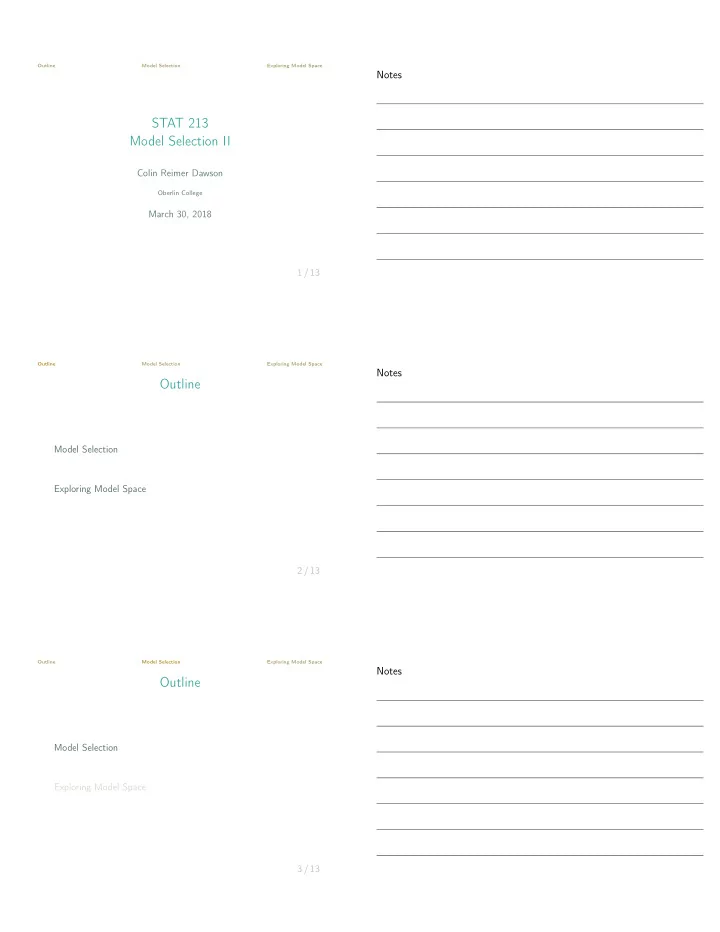

Outline Model Selection Exploring Model Space Notes STAT 213 Model Selection II Colin Reimer Dawson Oberlin College March 30, 2018 1 / 13 Outline Model Selection Exploring Model Space Notes Outline Model Selection Exploring Model Space 2 / 13 Outline Model Selection Exploring Model Space Notes Outline Model Selection Exploring Model Space 3 / 13
Outline Model Selection Exploring Model Space Notes So many models... • How to decide among all these models? 1. Understand the subject area! Build sensible models. 2. Nested F -tests 3. Model quality measures 4 / 13 Outline Model Selection Exploring Model Space Notes What Makes a Good Model? Fit High R 2 Small SSE Large F Validity Strong evidence for predictors Simple (Parsimonious) Generalizes outside sample 5 / 13 Outline Model Selection Exploring Model Space Notes Why Does Parsimony Matter? Don’t we just care about good predictions? Not exclusively... • We also use models to understand the world (harder with more complexity) And even so... • We really care about making predictions for data we haven’t seen yet . 6 / 13
Outline Model Selection Exploring Model Space Notes Criteria to “score” models 1. high R 2 /low SSE/low ˆ σ 2 ε : always prefers more complex models 2. Adj. R 2 : balances fit and complexity 3. Mallow’s C p / Akaike Information Criterion (AIC): σ 2 estimates mean squared prediction error based on ˆ ε from a “full” model 4. Out-of-sample predictive accuracy (next time) 7 / 13 Outline Model Selection Exploring Model Space Notes Mallow’s C p / AIC Two measures that reduce to the same thing in the case of MLR with independent, equal variance, Normal residuals. For a “reduced” model with p reduced total parameters (including the intercept) which is nested in a “full” model with p full parameters, both fit using n observations: C p = SSE reduced (1) + 2 p reduced − n MSE full = p reduced + SSE diff (2) MSE full where smaller values indicate a simpler model (smaller p reduced ) and/or a better fit (smaller SSE diff ) 8 / 13 Outline Model Selection Exploring Model Space Notes Outline Model Selection Exploring Model Space 9 / 13
Outline Model Selection Exploring Model Space Notes Model Selection Five predictor-selection methods: 1. Domain knowledge (+ a few F -tests) 2. Best subset 3. Forward selection 4. Backward selection 5. Stepwise selection 10 / 13 Outline Model Selection Exploring Model Space Notes Automated exploration of predictor subsets 1. Best subset: consider all possible combinations ( 2 K ) 2. Forward selection: start with null model, and consider adding one predictor at a time 3. Backward elimination: start with full model and consider removing one predictor at a time 4. Stepwise regression: consider both additions and subtractions at each iteration Note: Choose best step based on adj- R 2 or C p /AIC, not based on P -values 11 / 13 Outline Model Selection Exploring Model Space Notes Model Selection “Scoring” R 2 CV Error (next time) C p adj. Domain Knowledge Best Subset “Search” Forward Selection Backward Selection Stepwise Selection 12 / 13
Outline Model Selection Exploring Model Space Notes Example: Baseball Win % Demo 13 / 13 Notes Notes
Recommend
More recommend